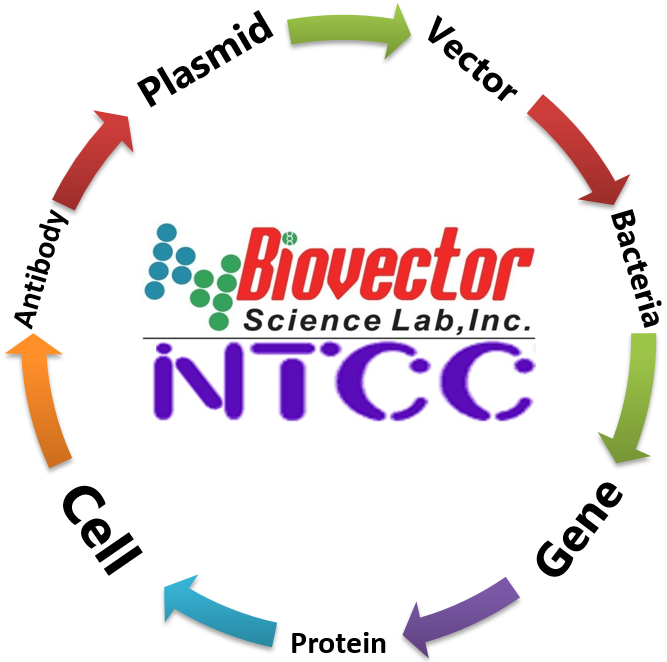flashBAC GOLD昆虫杆状病毒表达系统-BioVector NTCC质粒载体菌种细胞蛋白抗体基因保藏中心
- 价 格:¥98530
- 货 号:flashBAC GOLD
- 产 地:北京
- BioVector NTCC典型培养物保藏中心
- 联系人:Dr.Xu, Biovector NTCC Inc.
电话:400-800-2947 工作QQ:1843439339 (微信同号)
邮件:Biovector@163.com
手机:18901268599
地址:北京
- 已注册
flashBAC GOLD昆虫杆状病毒表达系统-BioVector NTCC质粒载体菌种细胞蛋白抗体基因保藏中心
Product Description
BaculovirusesBaculoviruses are insect viruses, predominantly infecting insect larvae of the order Lepidoptera (butterflies andmoths)1. A baculovirus expression vector is a recombinant baculovirus that has been genetically modified to contain aforeign gene of interest, which can then be expressed in insect cells under control of a baculovirus gene promoter. Themost commonly used baculovirus for foreign gene expression is Autographa californica nucleopolyhedrovirus(AcMNPV)2,3. AcMNPV has a circular, double-stranded, super-coiled DNA genome (133894 bp; Accession NC_001623)4,packaged in a rod-shaped nucleocapsid. The nucleocapsid can be extended lengthways and thus the DNA genome canaccommodate quite large insertions of DNA. The AcMNPV genome forms the basis of the flashBAC™ or BacPAK6 DNAprovided in this kit.AcMNPV has a bi-phasic life cycle (Figure 1) resultingin the production of two virus phenotypes: buddedvirus (BV) and occlusion-derived virus (ODV). BVcontain single, rod-shaped nucleocapsids enclosed byan envelope, derived from the plasma membrane ofinsect cells, containing a membrane-fusion proteinGP64 (Figure 2 A). GP64 is acquired when thenucleocapsids bud through the host cell plasmamembrane5. The BV form of the virus is 1000-foldmore infectious for cultured insect cells6, compared tothe ODV phenotype, and is responsible for cell-celltransmission in the early stages of infection7. It is theBV form of the virus that delivers the foreign gene intothe host insect cell for expression.Figure 1. A schematic representation of the bi-phasic life cycle ofbaculoviruses resulting in budded virus and occlusion-derived virus.P/PDV = polyhedra with occlusion derived virusECV = extracellular virus = budded virusIn the later stages of the infection cycle large numbers of occlusion bodies (OB) or polyhedra are formed inside thenuclei of cells (Figure 2 B & C). These consist of multiple rod-shaped nucleocapsids enclosed within an envelope,acquired de novo in the nucleus of cells, which then become embedded within a para-crystalline matrix of theOB/polyhedra. The major component of the OB matrix is comprised of a single protein – polyhedrin (29 kDa)8,9, whichis produced by the powerful transcriptional activity of the polyhedrin gene (polh) promoter13. OBs protect the virus andallow them to survive between hosts in the environment. Most baculovirus expression vectors do not producepolyhedra (see below for details), because the coding sequence for polyhedrin has been replaced by that of the foreigngene being expressed under control of the polh promoter. This is a useful safety feature because recombinant viruscannot persist in the environment in the absence of polyhedra.
flashBAC GOLD provides superior levels of expression for any protein that is destined for secretion or to be inserted in the membrane, or for any protein that might be particularly liable to degradation. flashBAC GOLD™ is a baculovirus expression vector that has been designed to reduce proteolysis, maximise protein secretion and improve membrane protein targeting and is based on our patented flashBAC™ system. The deletion of both chiA and v-cath genes from flashBAC GOLD™ has improved the efficacy of the secretory pathway and resulted in a greatly enhanced yield of recombinant proteins that are secreted or membrane targeted (in comparison to recombinant viruses that encode chiA and v-cath).
Using the flashBAC™ system is easier and quicker than other baculovirus expression systems because there is no need to separate recombinant virus from parental virus by plaque-purification or any other means; only recombinant virus is produced after the co-transfection. Because the production of recombinant virus has been reduced to a one step procedure in insect cells, it amenable to high throughput and automated production systems. However, it is also of benefit to the small research group just requiring one or a few recombinant baculoviruses prepared in individual dishes of cells.
Baculovirus genomes contain several auxillary genes, which are non-essential for replication in insect cell culture. One of these is chitinase (chiA), which encodes an enzyme with exo- and endochitinase activity. In an infected insect, chitinase together with the cysteine protease cathepsin, facilitates host cuticle breakdown and tissue liquefaction at the very late stages of infection, so releasing the virus to infect more hosts. Confocal and electron microscopy observations of insect cells infected with AcMNPV have shown that chitinase is targeted to the endoplasmic reticulum where it is densely packed in a paracrystalline array, severely compromising the function and efficacy of the secretory pathway. Deletion of chiA from flashBAC™ has improved the efficacy of the secretory pathway and resulted in a greatly enhanced yield of secreted and membrane targeted proteins. Deletion of v-cath reduces the chances of the recombinant protein being degraded.
The flashBAC system is a new platform technology for the production and isolation of recombinant baculoviruses.Importantly, flashBACTM has been designed to remove the need for separation of recombinant virus from parentalvirus, so no plaque-purification steps are needed. The production of recombinant virus has been simplified to a singlestage procedure that is fully amenable to high throughput manipulations – multiple recombinant viruses can be madeat one time using 24 well plates either manually or using simple robotic systems.The flashBACTM technology builds on the BacPAK6 technology. At the heart of the new system is an AcMNPV genomethat lacks part of the essential gene ORF 1629 and contains a bacterial artificial chromosome (BAC) at the polh locus,replacing the polh coding sequence. The essential gene deletion prevents virus replication in insect cells and the BACallows the virus genome to be maintained in bacterial cells as a bacmid. Circular virus DNA is isolated from bacterialcells and purified ready for use in flashBACTM kits and co-transfections to make recombinant viruses.A recombinant baculovirus is produced simply by co-transfecting insect cells with flashBACTM DNA and a transferplasmid containing the gene to be expressed (Figure 4). Homologous recombination within the insect cells (1) restoresORF 1629 allowing the recombinant virus to replicate (2) removes the BAC sequences and (3) inserts the foreign geneunder control of the polh promoter (or other promoter chosen that is in the transfer plasmid).The recombinant virus budded virus is harvested from the co-transfection medium and becomes the seed stock (P0) ofrecombinant virus. No selection systems are needed. However, the virus stock is not homogeneous in the way plaquepurifiedvirus is and for very large scale applications or for work that may be taken through regulatory processes, werecommend a single round of plaque-purification. For most purposes, however, plaque-purification is not necessary.This single step procedure greatly facilitates the high throughput production of baculovirus expression vectors viaautomated systems (Figure 5). However, it is just as useful for a research lab making one or two viruses in individualdishes. It is very useful for the novice.The flashBACTM system is back-compatible with all transfer plasmids based on homologous recombination at the polhlocus. The OET website has details of most of these and they include single, dual, triple and quadruple expressionplasmids, those with purification tags at N and C termini, and other promoters including p10, p6.9, ie-1 and, CMV (formammalian cells). It is not compatible with pFASTBacTM vectors and the Bac-toBac® system14.
Since the launch of the original flashBACTM DNA, we have made further modifications to help express difficult to expressproteins and the different flashBACTM variants are now described:flashBAC™ Backbone virus DNA has a chiA deletion, which prevents production of virus chitinase. Thisenzyme blocks the secretory pathway and its absence helps improve membrane andsecreted protein production15-18.flashBAC GOLD Backbone virus DNA has gene deletions for chiA and v-cath19. This avoids production ofchitinase and cathepsin, a viral protease that may otherwise degrade susceptible targetproteins. See Figure 6.flashBAC ULTRA Backbone virus DNA has deletions of chiA, v-cath and p10/p26/p74. Deletion of p10 resultsin delayed cell lysis (particularly noticeable) in TnHi5 cells and thus can extend proteinproduction times. It also reduces the metabolic burden on the cell of producing high levelsof P10 protein.flashBAC PRIME No gene deletions in the virus back bone. Useful if the proteins being expressed formcomplexes inside the cytoplasm or nucleus that need to be purified. We find that therelatively early cell lysis associated with PRIME makes it easier to purify these complexese.g. VLPs.Advantages of the flashBACTM system: Simple to use One step procedure that does not require plaque-purification (Figure 4) Amenable to making many viruses simultaneously – manually or using a robot in 24 well plates (Figure 4, 5) Amenable to high throughput systems Maximise secreted or membrane targeted proteins (Figure 6) Maximise difficult protein production Maximise VLP production and release from cells Back compatible with a large range of transfer plasmids Now compatible with Gateway® cloning system
QuickGuide:
Provided in kit:
flashBAC™ DNA (use 100ng [5µl] per co-transfection 20ng/µl)Positive-control vector DNA (use 500ng [5µl] per co-transfection 100ng/µl)To be provided by the user:• Transfection reagent – reagents tested and found to be successful: baculoFECTIN II (OET),Lipofectin® (Invitrogen), FuGENE 6 (Promega), GeneJuice® (Novagen).• Transfection media (e.g. Grace’s Insect Basal Medium or TC100).• 35mm tissue culture treated dishes seeded with Sf21 (1.4 x 106cells/2mls), or Sf9 (1x106cells/2mls) per dish.• Prepare 2 hours before transfection.• Sterile baculovirus transfer vector DNA containing gene of interest (500ng per cotransfection).Procedure: (as recommended with the use of baculoFECTIN II, other reagents may differ)A) Prepare DNA transfection complexes.1. Warm baculoFECTIN II to RT and vortex gently2. Place 100µl transfection medium in a sterile tube.3. Add 5µl (100ng) flashBAC™ DNA. Tap tube to mix.4. Add 5µl (500ng) plasmid transfer vector. Tap to mix.5. Add 1.2µl of baculoFECTIN II. Tap to mix.6. Incubate at RT for 15-20 minutes.B) Add DNA complexes to cells.1. Remove 1ml medium from each dish required2. Add baculoFECTIN II:DNA complex mixture drop-wise to different areas of thedish.3. Incubate 16-24 hours4. Add 1ml fresh medium to each culture dish.5. Incubate for 4 days at 28°C (5 days from start of co-transfection).C) Harvest P0 virus stock.1. Aspirate medium from dishes and remove cells @ 3000 rpm/10 mins2. Amplify virus stock using recommended protocols (www.oetltd.com) Related OET products:Transfection Reagents:baculoFECTIN II 150µl and 1mlflashFECTIN: 300µl and 1 mlTransfection medium:Expression System: 20ml and 100ml transfection mediaVirus titration tool:baculoQUANT all-in-oneSf21 (plaque assay cells)Plaque assay service work
Cell culture media:Expression systems insect cell culture media
Manual说明书:
Contact BioVector NTCC Inc.
- 公告/新闻




